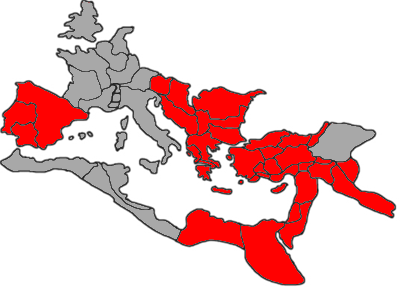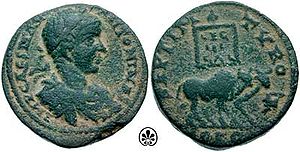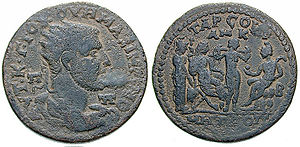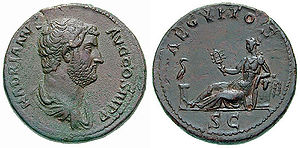
Roman provincial coins
Encyclopedia

Roman Empire
The Roman Empire was the post-Republican period of the ancient Roman civilization, characterised by an autocratic form of government and large territorial holdings in Europe and around the Mediterranean....
by civic authorities rather than by Imperial authorities. Often these coins were a continuation of the original currency system that existed prior to the arrival or conquest by the Romans
Ancient Rome
Ancient Rome was a thriving civilization that grew on the Italian Peninsula as early as the 8th century BC. Located along the Mediterranean Sea and centered on the city of Rome, it expanded to one of the largest empires in the ancient world....
.
Alloys





Provincial coins were issued in bronze and silver denominations, though never gold.
The majority of the coins
COinS
ContextObjects in Spans, commonly abbreviated COinS, is a method to embed bibliographic metadata in the HTML code of web pages. This allows bibliographic software to publish machine-readable bibliographic items and client reference management software to retrieve bibliographic metadata. The...
issued by the provincial mints were of bronze
Bronze
Bronze is a metal alloy consisting primarily of copper, usually with tin as the main additive. It is hard and brittle, and it was particularly significant in antiquity, so much so that the Bronze Age was named after the metal...
. Silver
Silver
Silver is a metallic chemical element with the chemical symbol Ag and atomic number 47. A soft, white, lustrous transition metal, it has the highest electrical conductivity of any element and the highest thermal conductivity of any metal...
coins were common in regions of the Eastern Empire (particularly Alexandria
Alexandria
Alexandria is the second-largest city of Egypt, with a population of 4.1 million, extending about along the coast of the Mediterranean Sea in the north central part of the country; it is also the largest city lying directly on the Mediterranean coast. It is Egypt's largest seaport, serving...
). In general the issue of silver coinage was controlled by Rome. This was because by controlling the issue of silver coins (denarius
Denarius
In the Roman currency system, the denarius was a small silver coin first minted in 211 BC. It was the most common coin produced for circulation but was slowly debased until its replacement by the antoninianus...
), the Roman government could control and influence events in the provinces. The coins issued by a city were mostly used by the inhabitants of that city in local transactions. When a new region was assimilated by Rome, the Romans would frequently allow the continuation of the original currency as a matter of expediency. Frequently, when a new Colony was formed it would be given authority to mint bronze coins.
Mints

The mint
Mint (coin)
A mint is an industrial facility which manufactures coins for currency.The history of mints correlates closely with the history of coins. One difference is that the history of the mint is usually closely tied to the political situation of an era...
s were located in major provincial cities such as Corinth
Corinth
Corinth is a city and former municipality in Corinthia, Peloponnese, Greece. Since the 2011 local government reform it is part of the municipality Corinth, of which it is the seat and a municipal unit...
or
Antioch
Antioch
Antioch on the Orontes was an ancient city on the eastern side of the Orontes River. It is near the modern city of Antakya, Turkey.Founded near the end of the 4th century BC by Seleucus I Nicator, one of Alexander the Great's generals, Antioch eventually rivaled Alexandria as the chief city of the...
. There are several cities which are only known by their coins, as there is no historical mention of them.
Some mints issued only for that city (Viminacium
Viminacium
Viminacium was a major city and military camp of the Roman province of Moesia , and the capital of Moesia Superior. The archeological site occupies a total of 450 hectares. Viminacium is located 12 km from Kostolac, was devastated by Huns in the 5th century, but rebuilt by Justinian...
), while others issued coins for a larger province (Moesia
Moesia
Moesia was an ancient region and later Roman province situated in the Balkans, along the south bank of the Danube River. It included territories of modern-day Southern Serbia , Northern Republic of Macedonia, Northern Bulgaria, Romanian Dobrudja, Southern Moldova, and Budjak .-History:In ancient...
).
Denominations
The denominations of most bronze coins are unknown, though there are some exceptions such as the GreekAncient Greece
Ancient Greece is a civilization belonging to a period of Greek history that lasted from the Archaic period of the 8th to 6th centuries BC to the end of antiquity. Immediately following this period was the beginning of the Early Middle Ages and the Byzantine era. Included in Ancient Greece is the...
Obolus
Obolus
The obol was an ancient silver coin. In Classical Athens, there were six obols to the drachma, lioterally "handful"; it could be excahnged for eight chalkoi...
(which was originally a silver coin, but came to be issued in bronze) and Chalkous. It is believed that some were based upon proper Roman denominations such as the as
As (coin)
The , also assarius was a bronze, and later copper, coin used during the Roman Republic and Roman Empire.- Republican era coinage :...
and sestertius
Sestertius
The sestertius, or sesterce, was an ancient Roman coin. During the Roman Republic it was a small, silver coin issued only on rare occasions...
. The legends on the coins are usually written in Greek
Ancient Greek
Ancient Greek is the stage of the Greek language in the periods spanning the times c. 9th–6th centuries BC, , c. 5th–4th centuries BC , and the c. 3rd century BC – 6th century AD of ancient Greece and the ancient world; being predated in the 2nd millennium BC by Mycenaean Greek...
or Latin
Latin
Latin is an Italic language originally spoken in Latium and Ancient Rome. It, along with most European languages, is a descendant of the ancient Proto-Indo-European language. Although it is considered a dead language, a number of scholars and members of the Christian clergy speak it fluently, and...
, depending of the area of issue. They most likely were only circulated at a local level as their trade value would have been small. Judging by the wear and condition of these coins it is obvious they were in circulation for a very long time. Many of the coins have a dimple or center depression not always located in the exact center. The purpose of this mark is undetermined as several plausible explanations exist.

